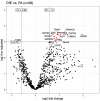Comparing gene expression in deep infiltrating endometriosis with adenomyosis uteri: evidence for dysregulation of oncogene pathways
- PMID: 37005590
- PMCID: PMC10067221
- DOI: 10.1186/s12958-023-01083-9
Comparing gene expression in deep infiltrating endometriosis with adenomyosis uteri: evidence for dysregulation of oncogene pathways
Abstract
Background: The pathogenesis of deep infiltrating endometriosis (DIE) is poorly understood. It is considered a benign disease but has histologic features of malignancy, such as local invasion or gene mutations. Moreover, it is not clear whether its invasive potential is comparable to that of adenomyosis uteri (FA), or whether it has a different biological background. Therefore, the aim of this study was to molecularly characterize the gene expression signatures of both diseases in order to gain insight into the common or different underlying pathomechanisms and to provide clues to pathomechanisms of tumor development based on these diseases.
Methods: In this study, we analyzed formalin-fixed and paraffin-embedded tissue samples from two independent cohorts. One cohort involved 7 female patients with histologically confirmed FA, the other cohort 19 female patients with histologically confirmed DIE. The epithelium of both entities was microdissected in a laser-guided fashion and RNA was extracted. We analyzed the expression of 770 genes using the nCounter expression assay human PanCancer (Nanostring Technology).
Results: In total, 162 genes were identified to be significantly down-regulated (n = 46) or up-regulated (n = 116) in DIE (for log2-fold changes of < 0.66 or > 1.5 and an adjusted p-value of < 0.05) compared to FA. Gene ontology and KEGG pathway analysis of increased gene expression in DIE compared to FA revealed significant overlap with genes upregulated in the PI3K pathway and focal adhesion signaling pathway as well as other solid cancer pathways. In FA, on the other hand, genes of the RAS pathway showed significant expression compared to DIE.
Conclusion: DIE and FA differ significantly at the RNA expression level: in DIE the most expressed genes were those belonging to the PI3K pathway, and in FA those belonging to the RAS pathway.
Keywords: Adenomyosis; Deep infiltrating endometriosis; Gene expression analysis; PI3K pathway; RAS pathway.
© 2023. The Author(s).
Conflict of interest statement
The author(s) declared no potential conflicts of interest with respect to the research, authorship, and/or publication of this article.
Figures




References
-
- Chapron C, Fauconnier A, Vieira M, Barakat H, Dousset B, Pansini V et al. Anatomical distribution of deeply infiltrating endometriosis: surgical implications and proposition for a classification.Human Reproduction. 2003;18:157–61. - PubMed
MeSH terms
Substances
LinkOut - more resources
Full Text Sources
Medical

